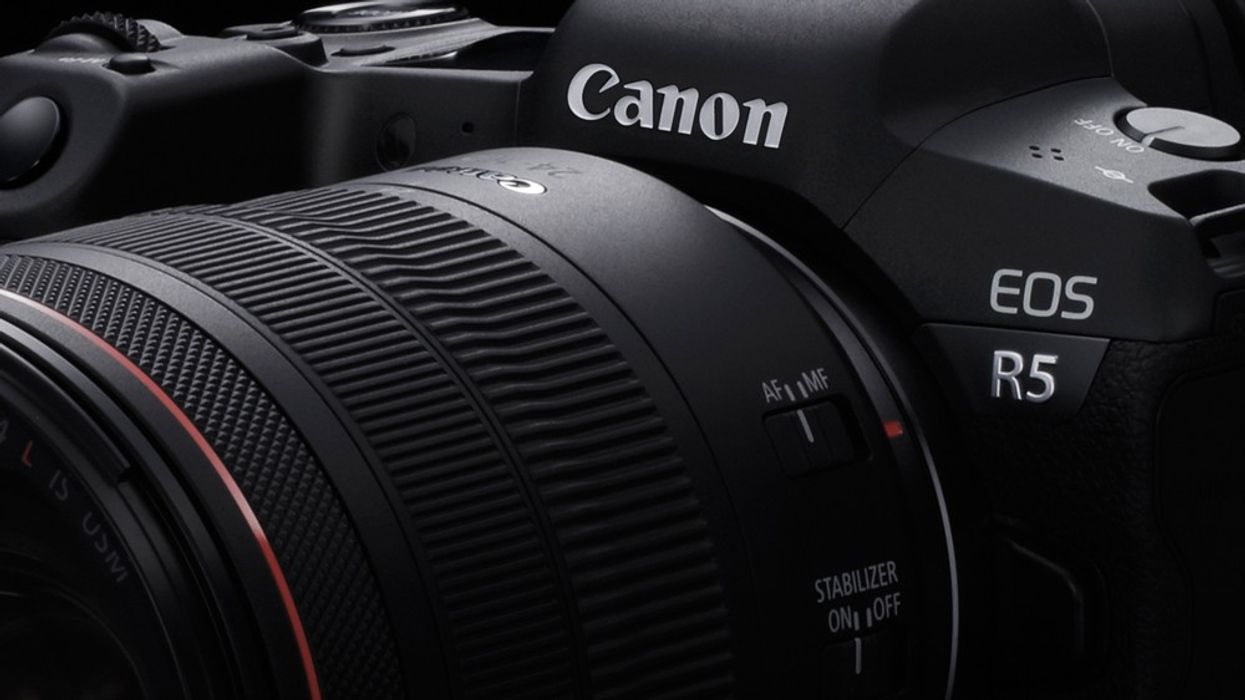Canon Confirms Internal 8K RAW and 4K 4:2:2 10-bit for EOS R5
Canon continues to check boxes on the EOS R5 spec sheet.

After Canon confirmed it was developing the EOS R5, the next camera in its full-frame mirrorless R System, the company has been steadily announcing new features leading up to its release. One such spec is its internal 8K recording without crop.
Today, Canon has shared new EOS R5 information including chroma subsampling, bit depth, and codec capabilities. Oh, and it will record 8K RAW internally.
EOS R5 Confirmed Specs
- 8K RAW internal recording up to 29.97fps
- 8K internal recording up to 29.97fps in 4:2:2 10-bit Canon Log (H.265)
- 8K internal recording up to 29.97fps in 4:2:2 10-bit HDR PQ (H.265)
- 4K internal recording up to 119.88fps in 4:2:2 10-bit Canon Log (H.265)
- 4K internal recording up to 119.88fps in 4:2:2 10-bit HDR PQ (H.265)
- 4K external recording is also available up to 59.94 fps
- Dual Pixel CMOS AF available in all 8K and 4K recording modes
- Canon Log available in 8K and 4K internal recording modes
- 5-axis In-Body Image Stabilization; works with Optical IS on RF and EF lenses
- Dual-card slots: 1x CFexpress and 1x SD UHS-II
Up until now, Canon only confirmed that the EOS R5 would record 8K and 4K resolutions internally without crop. New information has emerged about the type of recording formats. The full-frame mirrorless will record 8K RAW internally, 8K 4:2:2 10-bit Canon Log and 4:2:2 10-bit HDR PQ up to 29.97fps using H.265 (HEVC).
Internal 4K will also see 4:2:2 10-bit Canon Log and 4:2:2 10-bit HDR PQ up to 29.97. But the question on my mind was is it 4K DCI or 4K UHD. Well, Canon released some of that puzzle too, maybe by accident. One of the bullet points released by Canon said:
- No crop 8K and 4K video capture using the full-width of the sensor.*
Note the asterisk. What did it reference? *When in 8K RAW, 8K or 4K DCI modes.
Now, it's known the EOS R5 will record 4K DCI at 4:2:2 10-bit Canon Log and HDR PQ up to 29.97fps. Yes, it's H.265, but that's a good thing since the codec is more widely supported by non-linear editors today. You might recall the Samsung NX series, and the NX1 flagship that came out in 2014. Its downfall was partially due to the early adoption of H.265. It required files to be converted from H.265 files to H.264 first to be used with Adobe Premiere or Final Cut as the software didn't support the codec until later. With computer processing improving, will the smaller H.265 may now finally become mainstream.
One last point about that asterik. It makes me wonder if other modes will have a crop factor. Let's say, there's a 4K UHD mode. Will that have a crop factor? Will certain external modes have a crop factor? It's something to keep an eye on as Canon continues to develop the EOS R5
What we do know is that the camera will record external 4K up to 59.94fps. There are no specifics on if the 4K will be DCI or UHD or what chroma subsampling, bit depth codec, gamma, or crop factor. All that's known is it will be 4K up to 59.94fps.
Canon RAW
So what type of RAW will the EOS R5 record? Canon has two RAW formats Cinema RAW and Cinema RAW Light. Cinema RAW is uncompressed and requires an external recorder to capture the images. The EOS C700FF touts the feature, and currently, only the Codex CDX-36150 external recorder supports Cinema RAW, which tacks on an additional $7,000 if bought outright. So its safe to rule out Canon's uncompressed RAW.
Cinema RAW Light is the likely culprit unless Canon develops a new version of RAW for the camera specifically. Cinema RAW Light works differently than RED's REDCODE RAW or Blackmagic's BRAW visually lossless codecs. With REDCODE and BRAW, the amount of compression can be selected from 2:1 on up.
With Cinema RAW Light, the compression is standardized, around 5:1, and retains a lot of the quality of the uncompressed version. It also requires a different post-production process than traditional RAW workflows. Cinema RAW Light doesn't record using the traditional RAW frame-by-frame file structure. Instead, it complies the RAW information into a single Canon RAW (.CRM) file. The .CRM acts as a container for the RAW sensor data which can be unpacked, debayered, and modified using Canon's software before being exported to the format of choice.
Our wonder is if Canon will offer Cinema RAW Light as an external option on the EOS R5 down the road.
C-Log will be available internally on the EOS R5 via 8K and 4K. It's safe to assume the original Canon Log is an option, but there's nothing definitive on Log2 or Log3. Canon might be reserving those gamma curves for its cinema line which is supported by the C500 MK II, C300 MK III, and others.
The original EOS R did receive and update that allowed it to record 4K 4:2:2 10-bit Log externally to Atomos, but with a 1.73x crop factor. All signs point to Canon not having a crop factor on the EOS R5 except for that asterisk mentioned earlier.
IBIS
The EOS R5 will have a 5-axis in-body image stabilization that will work with the optical image stabilization found on the RF and EF lenses. This is becoming a new trend with camera manufacturers. With third-party lenses made by Tamron, Sigma, and others, the idea is that the lens and camera combination will offer more stability over a third-party lens. That said, it will be something worth testing down the line in order to weigh cost-benefit ratio.
Storage
There will be two card slots on the camera. One CFexpress and one SD UHS-II. This is a similar configuration to the Sony FX9. The thinking here is probably to have the faster CFexpress cards record the RAW and higher resolutions, leaving the possibility of the proxy workflow with the SD UHS-II cards.
Final Thoughts
Canon is checking many imporant spec boxes on the EOS R5, which is a good thing for creators. It's worth noting though, Canon is playing catch up. The 1.73x crop factor on the EOS R did not go over well with filmmakers looking for full-frame 4K. All signs point to Canon not making the same mistake twice here.
The Panasonic S1H already has a huge leg up and Sony is somewhat quietly developing its highly anticipated a7s III. When Canon released its 2019 sales reports in Q2, it showed a sharp decline because of market competition. It looks like Canon is trying to right the ship with the EOS R5.
What are your thoughts on the EOS R5? Let us know in the comments below.




 Go Behind the Scenes of the Filming of 'Killers of the Flower Moon'
Go Behind the Scenes of the Filming of 'Killers of the Flower Moon' BTS of Spike Jonze's Apple Ad Apple
BTS of Spike Jonze's Apple Ad Apple









